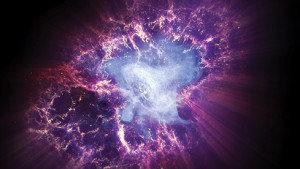When I consider your heavens, the work of your fingers, the moon and the stars, which you have set in place, what is man that you are mindful of him, the son of man that you care for him?” (Psalm 8:3, 4).
King David—the shepherd poet of Israel—and observant people from China, Greece, Peru and elsewhere have looked at the stars for millennia. On a clear, moonless night, they could see as many as 3000 stars. Over the years, they recorded their sightings of eclipses, comets and meteor showers. They also made out figures—constellations and “wandering stars”—the five easily visible planets. No-one dreamed that an even more vast universe awaited discovery.
Enter Galileo Galilei (1564-1642).
This Italian mathematician and astronomer became the first to pull back the veil. On a cold winter night in 1610, he pointed his tiny spyglass (later called a telescope) toward the planet Jupiter and found four small bodies revolving around it. In rapid succession he discovered mountains and craters on the moon, spots on the sun, and the phases of Venus.
For nearly four centuries, astrono mers have used optical telescopes of many types and sizes to increase our knowledge of the universe.
Fast forward to the 20th century.
Grote Reber built the first radio (dish type) telescope after Karl Jansky detected intense radio waves from the direction of the Galactic Center. Radio astronomers brought to view a whole new field of space exploration, as they studied electromagnetic waves longer than those of visible light.
Galactic Center
A galaxy is defined as a large assemblage of stars, gas and dust bound together by their mutual gravitational attraction. The Milky Way galaxy is shaped like a disk. It's middle is called the Galactic Center. Our sun is located about two-thirds of the way out.
Before 1920, most astronomers believed that our Milky Way Galaxy contained all the stars in the universe.
The fuzzy-looking objects discovered by William Herschel, his sister, Caroline, and son, John, called nebulae (singular nebula) were thought to be glowing interstellar gaseous clouds. The best known, easily visible in the Northern Hemisphere, is the so-called Andromeda Nebula.
The Large and Small Magellanic Clouds are large fuzzy patches of light, visible from the Southern Hemisphere.
A few brave souls dared to disagree with the majority that all stars belong to our Milky Way galaxy. In 1755, German philosopher Immanuel Kant suggested in his book, General Natural History and Theory of the Heavens, that many galaxies like our own exist in outer space. He called them “island universes,” speculating that our own stellar system was shaped like a flattened disk. He thought that they were similar and strewn randomly throughout space.
Astronomer William Parsons, third earl of Rosse, discovered that the Whirlpool Nebula, M51, had massive double arms. He immediately surmised that it was a spinning disk of stars. Modern photography has proven him right.
the Shapley–Curtis debate
In April 1920, at the National Academy of Sciences in Washington, DC, the Shapley–Curtis debate took place.
Harlow Shapley of Harvard argued in favour of the traditional idea of one large Milky Way galaxy with spiral nebulae scattered around in it. Heber Curtis of Lick Observatory affirmed Kant's idea of many “island universes”—later know as galaxies—with our Milky Way galaxy only one of many. Nothing was decided at the conclusion of the debate.
Enter Edwin Hubble. Three years later, the Mount Wilson (USA) astronomer settled the issue forever. By observing Cepheid Variables and using discoveries of Harvard astronomer Henrietta Leavitt, Hubble determined that Andromeda was a large galaxy located 2.2 million light-years beyond the Milky Way—not a nebula within it.
He pulled back the veil on a vast universe of many galaxies.
Hubble spent his career using the Mount Wilson telescopes to classify the types of galaxies. Some are spiral, while others are elliptical or irregular in shape. Like the Milky Way, each galaxy contains billions of stars bound together by gravity. Our solar system is rotating at 828,000 kilometres an hour around the centre of our galaxy in an anti-clockwise direction.
Trailblazing astronomer Elwin Hubble died in 1953 but his work of increasing our knowledge of the universe did not stop. In 1946, astronomer Lyman Spitzer wrote a paper discussing the advantages of a space-based telescope, far above the turbulence of earth's atmosphere.
Eventually, the National Aeronautics and Space Administration (NASA), with the collaboration of the European Space Agency, took over the project of the construction of a large space telescope.
Since Edwin Hubble had been the first to discover galaxies outside of the Milky Way, the new orbiting telescope was named the Hubble Space Telescope (HST) in his honour. Equipped with a 2.4 metre reflector telescope, cameras and spectrographs, HST orbits the earth every 97 minutes, 575 kilometres above the Earth's surface.
Far above the distorting effects of Earth's atmosphere, HST has furnished astronomers with unprecedented deep and clear views of the universe, ranging from our own solar system to extremely remote galaxies.
This giant eye in the sky has revealed galaxies billions of light years away. It has photographed clusters of galaxies that occur in clumps, called superclusters.
The “Local Group” numbers some 40 galaxies, with Andromeda and our own Milky Way the largest.
Out beyond the Local Group, the Hubble Space Telescope has revealed the existence of between 50 billion and one trillion galaxies. Such figures boggle the mind! Astronomers are not satisfied with the successes of the HST in increasing our knowledge of the universe. A much larger James Webb Space Telescope is now under construction, scheduled for launching in 2013.
undiscovered wonders
To the believers of the Bible, these recent discoveries present strong evidence of the power and wisdom of our Creator God. The shepherd-poet marvelled at the few stars he observed. He exclaimed, “O Lord, our Lord, how majestic is your name in all the earth! You have set your glory above the heavens” (Psalm 8:1).
On considering the moon and the stars, King David declares “What is man ... ?”—poor, puny human beings that we are, in the presence of the Creator of a vast universe. What would David say if he could see today's space telescope photos? Within a few generations, human knowledge of galaxies has progressed from one to myriads. Who can guess what wonders await us?
These wonders reveal an intelligent Being, who is worthy of our sincere adoration and worship. He is our Creator and Redeemer, Jesus Christ.






